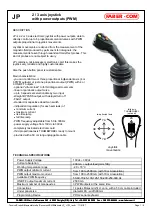
Table 2: Mechanical Guards
Distance of opening
Maximum width
from point of operation
of opening
hazard (inches)
(inches)
1/2
to
1-1/2
1/4
1-1/2
to
2-1/2
3/8
2-1/2
to
3-1/2
1/2
3-1/2
to
5-1/2
5/8
5-1/2
to
6-1/2
3/4
6-1/2
to
7-1/2
7/8
7-1/2
to
12-1/2
1-1/4
12-1/2
to
15-1/2
1-1/2
15-1/2
to
17-1/2
1-7/8
17-1/2
to
31-1/2
2-1/8
Safeguarding with Mechanical Guards
When a light system is used to protect the operator or
passerby from penetration, it must be mounted and
properly sized (grid length) so it is impossible to reach
under, around, or over into the hazardous point of
operation zone. Infrared light systems normally guard
the front or feed area of a machine. The sides or the
areas where the light screen does not guard must be
guarded by some other means.
If the position of the safety light curtain will allow the
operator or others to place themselves between the
sensing field and the hazardous area, auxiliary guards or
devices such as safety mats, barrier guards, or devices
should be used in conjunction with the safety light
curtain to prevent the operator or others from exposure
to the hazardous area. If mechanical guards such as
polyurethane, expanded or perforated metal, hairpins,
etc. are used to guard these areas, the opening must
comply with the OSHA safety distance in relationship
to the openings.
After installation of point of operation guards and before
a job is released for operation, a check should be made
to verify that the guard will prevent the operators hands
from reaching into the point of operation or any hazard
zone.
Table 2 outlines the distances that guards should be
positioned from the nearest point-of-operation hazards.
The various openings are such that for average-sized
hands, an operator’s fingers will not reach the point of
operation.
After installation of point-of-operation guards and before
a job is released for operation, a check should be made
to verify that the guard will prevent the operator’s hands
or other body parts from reaching the point of operation.
Light Curtain Test Procedure
Use a dowel rod (or similar object) with a diameter
equal to the M.O.S. (Minimum Object Sensitivity) of
the guard you are testing. Move the rod through the
field of the curtain (i.e. top to bottom for vertically
mounted curtains). Repeat this test close to the Emit-
ter pylon, close to the Receiver pylon, in the middle
between the pylons, and most importantly in front of
the operator position.
Make sure the curtain indicates a “Blocked” condition
(RED light) when the rod is in the field of the curtain.
Check and make sure the machine cannot move
when the curtain shows “Blocked”. If the machine can
operate while the curtain shows a “Blocked” condition,
then re-examine your wiring.
If the curtain does not show “Blocked” when the rod
is in the field: Check to make sure the rod is truly in
the curtain’s field, and re-check the curtain’s Minimum
Object Sensitivity (including AutoBlank and Floating
blank options that change the M.O.S.).
Infrared light from the curtain may be reflecting
around the rod due to reflective material too close
to the curtain’s field. In this case, you will have to
move the curtain pylons back away from the reflective
material and repeat the test over again. The curtain’s
power level can also be reduced by the factory.
Installation Procedures
Metal Box Controller Module
12
Содержание microguard
Страница 1: ...Installation Manual for the Metal Box Controller Module ...
Страница 45: ...NOTES ...
Страница 46: ...NOTES ...
















































